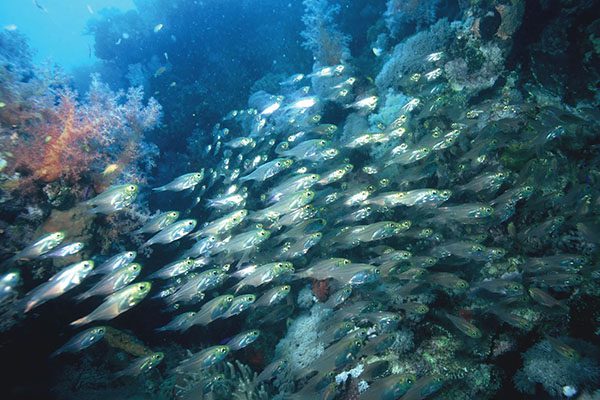The Living Cloud: Ecology & Dynamics of Glassfish (Parapriacanthus spp.) in Marsa Alam
Beneath the sun-drenched waves of Marsa Alam, the Red Sea pulsates with an intricate web of life. While many creatures assert their presence with vibrant colors or commanding size, others thrive through sheer numbers and ingenious collective dynamics. Among these are the unassuming yet ecologically vital Glassfish (Parapriacanthus spp.). These translucent, shimmering masses are far more than just a beautiful spectacle; they represent a critical nexus in the reef’s food web, a living, breathing cloud of energy and survival. Sambo Divers Marsa Alam delves beyond the mesmerizing surface, inviting you to explore the fascinating ecology and profound importance of these tiny, yet mighty, inhabitants.
Small but Significant: The Biology of Parapriacanthus spp.
Glassfish, classified within the genus Parapriacanthus, are small, silvery fish belonging to the family Pempheridae or sometimes treated separately. Their biology is finely tuned to their role as a collective:
- Physical Adaptations for Schooling: Their laterally compressed, often transparent bodies with large eyes are ideal for perceiving light changes and reacting to the movements of their neighbors, enabling the synchronized movements characteristic of large schools. Their small size means that while individually vulnerable, collectively they present a formidable, confusing target.
- Diet: Glassfish primarily feed on zooplankton, tiny marine animals drifting in the water column. They are crucial grazers of this plankton, converting microscopic energy into a larger, more accessible form for predators.
- Rapid Reproduction: To compensate for their high predation rates, Glassfish likely have a high reproductive output, releasing numerous eggs into the water column (broadcast spawning) to ensure the continuation of their species.
Survival in Numbers: The Dynamics of the Living Cloud
The defining characteristic of Glassfish is their intensely social, schooling behavior. This is not merely a social preference but a sophisticated survival strategy:
- Predator Dilution Effect: In a large school, the chance of any single individual being targeted and eaten by a predator is significantly reduced. It’s simply harder for a predator to pick out one fish from thousands.
- Predator Confusion Effect: The sheer volume and synchronized, often erratic, movements of a dense school can overwhelm and confuse predators. The constantly shifting patterns make it difficult for an attacker to lock onto a single target, often leading to missed strikes or abandonment of the chase.
- Collective Vigilance: While individual Glassfish might have limited sensory range, the collective “awareness” of a school is immense. Any movement or change in light detected by one fish can instantly trigger a reaction that ripples through the entire group, allowing for rapid escape.
- Shelter and Security: During the day, Parapriacanthus spp. seek the protective embrace of sheltered spaces. In Marsa Alam, this means:
- Reef Overhangs and Grottos: These provide crucial shade and a physical barrier from open-water predators.
- Inside Wrecks and Caves: The confined, dark interiors of wrecks like the Salem Express or the numerous natural caverns found at sites like Elphinstone or Daedalus offer perfect sanctuaries.
- Nocturnal Foraging: At night, when many diurnal predators are less active, Glassfish often disperse slightly from their dense schools to forage more widely for plankton, before regrouping in their shelters by daybreak.
A Crucial Link: Importance in the Red Sea Food Web
Beyond their mesmerizing beauty, Glassfish play an indispensable role in the Red Sea’s food web:
- Primary Food Source: They are a fundamental link between the microscopic world of plankton and the larger predatory fish. Schools of Glassfish represent a massive caloric resource, serving as a primary food source for a wide array of marine predators, including:
- Jacks and Trevally: Large schools of jacks are frequently seen circling and ambushing Glassfish aggregations.
- Barracuda: Solitary or schooling barracuda often hover near Glassfish schools, waiting for an opportunity.
- Tuna and Other Pelagic Fish: These fast-moving hunters will target Glassfish when they venture out from their shelters.
- Reef Sharks: Even some reef sharks will opportunistically feed on dense schools.
- Witnessing the Hunt: For divers, witnessing a feeding frenzy around a Glassfish school is an exhilarating and raw display of nature’s power – a poignant reminder of the continuous struggle for survival and the intricate balance of the ecosystem.
Conservation and Responsible Observation with Sambo Divers Marsa Alam
The living clouds of Glassfish (Parapriacanthus spp.) in Marsa Alam are a marvel of collective biology and a vital component of the Red Sea’s dynamic marine life. Sambo Divers Marsa Alam is committed to their preservation:
- Respectful Interaction: We guide divers to observe Glassfish with minimal disturbance, ensuring slow movements and impeccable buoyancy to avoid stressing the schools.
- Habitat Protection: Protecting the integrity of the caves, wrecks, and overhangs where Glassfish seek refuge is paramount. We educate divers on avoiding contact with these delicate environments.
- Ecosystem Awareness: By understanding the Glassfish’s crucial role as a food source, divers gain a deeper appreciation for the interconnectedness of all species and the importance of preserving the entire reef ecosystem.
To dive amidst the vibrant, pulsating cloud of Glassfish (Parapriacanthus spp.) in Marsa Alam is to witness a core element of the Red Sea’s wild heart. Join Sambo Divers Marsa Alam for an unforgettable journey into these dynamic living formations, where every shimmer speaks volumes about survival, community, and the profound beauty of the underwater world.




0 Comment